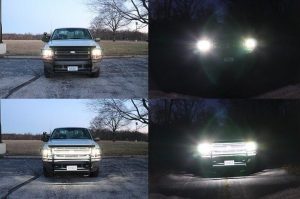New Lighting System Helps Deer Avoid Vehicles at Night
By USDA APHIS
7/29/2020

These images show the difference in the “looming” appearance of approaching vehicles equipped with headlights (top) versus headlights plus the new rear-facing LED light (bottom).
Researchers with the U.S. Department of Agriculture’s (USDA) Wildlife Services (WS) program recently applied for a patent (U.S. Patent Application No. 16/668,253) for a new vehicle-based lighting system to prevent deer-vehicle collisions during low-light conditions.
Through a series of experiments with free-roaming white-tailed deer, researchers at the WS program’s National Wildlife Research Center (NWRC) found the use of a rear-facing light-emitting diode (LED) light bar‒which illuminates a larger portion of the vehicle’s front surface than standard headlights alone‒resulted in fewer dangerous deer-vehicle interactions. The likelihood of dangerous interactions decreased from 35% to only 10% of vehicle approaches when using a rear-facing light bar plus headlights versus just headlights alone. The reduction in dangerous interactions appeared to be driven by fewer instances of immobility or “freezing” behavior by deer when the light bar was used. The study “Frontal vehicle illumination via rear-facing lighting reduces potential for collisions with white-tailed deer” is highlighted in the latest issue of the journal Ecosphere.
“This new lighting system takes advantage of a deer’s predator avoidance behavior (also known as flight behavior),” states lead author and former NWRC researcher Dr. Travis DeVault who currently serves as the associate director of the University of Georgia’s Savannah River Ecology Laboratory. “We predicted that light reflected from the front surface of the vehicle would provide a more reliable looming image to deer, thus encouraging the deer to move out of the path of the approaching vehicle.”
When an object “looms,” it becomes increasingly larger to the perceiving animal, helping the animal realize that the object is an approaching object versus one that is stationary.
Read more here: https://www.aphis.usda.gov/aphis/newsroom/stakeholder-info/sa_by_date/sa-2020/sa-07/nwrc-deer-lights
Read the study in Ecosphere here: https://esajournals.onlinelibrary.wiley.com/doi/10.1002/ecs2.3187